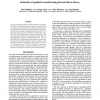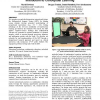281 search results - page 30 / 57 » Learning to Apply Theory of Mind |
AI
2011
Springer
13 years 2 months ago
2011
Springer
Qualitative models are often a useful abstraction of the physical world. Learning qualitative models from numerical data sible way to obtain such an abstraction. We present a new ...
CHI
2011
ACM
12 years 11 months ago
2011
ACM
We introduce an embodied-interaction instructional design, the Mathematical Imagery Trainer (MIT), for helping young students develop grounded understanding of proportional equiva...
CVPR
2000
IEEE
14 years 9 months ago
2000
IEEE
Many problems in vision can be formulated as Bayesian inference. It is important to determine the accuracy of these inferences and how they depend on the problem domain. In recent...
JCIT
2010
13 years 2 months ago
2010
Probability theory is the framework for making decision under uncertainty. In classification, Bayes' rule is used to calculate the probabilities of the classes and it is a bi...
HICSS
2003
IEEE
14 years 27 days ago
2003
IEEE
Basically, instrumental conditioning is learning through consequences: Behavior that produces positive results (high “instrumental response”) is reinforced, and that which pro...


